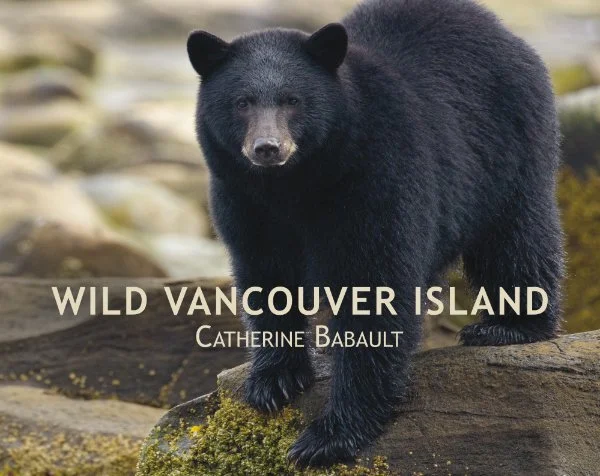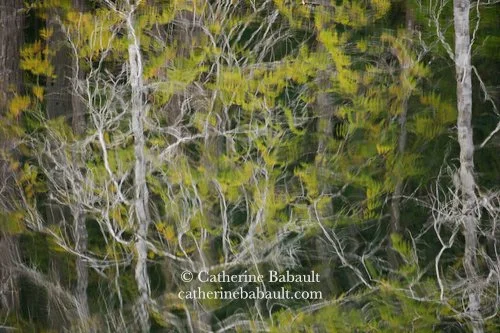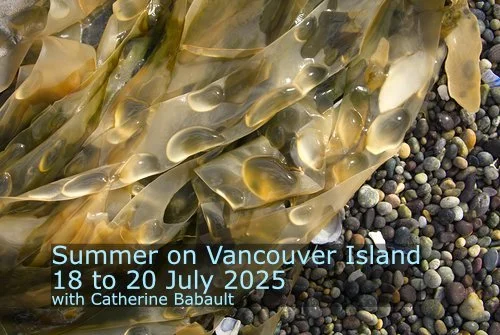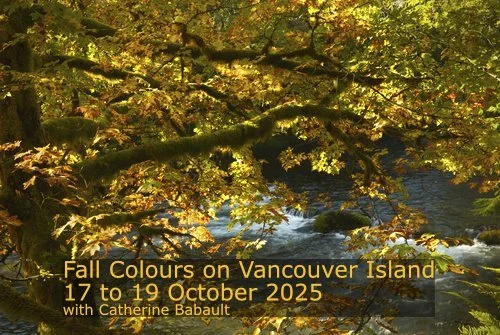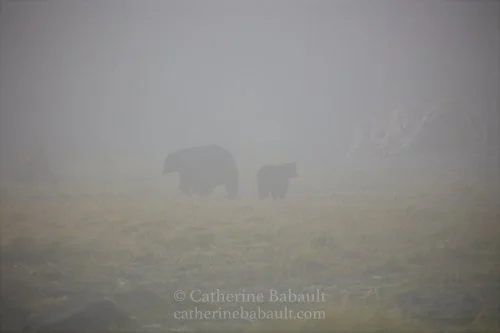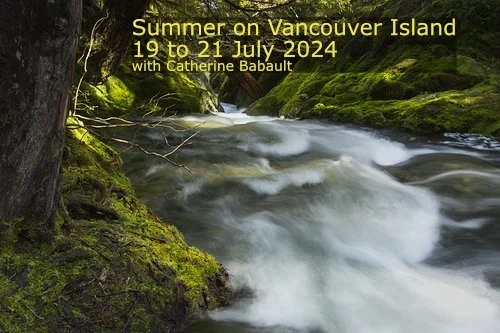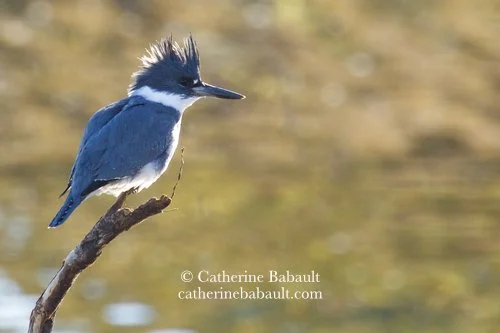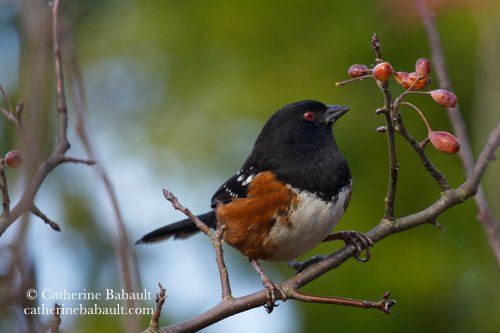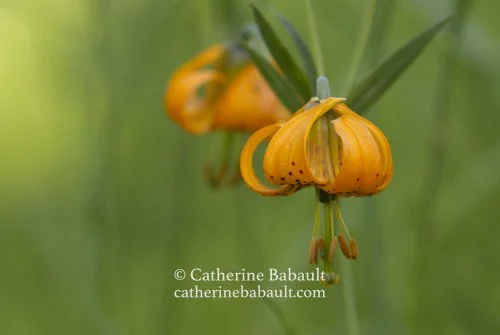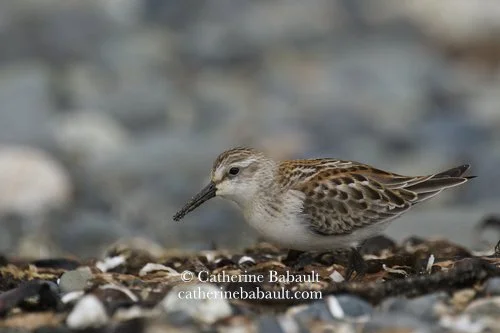Unique photo opportunities to capture black bears catching salmon, Roosevelt elk herds during the rutting period, and sea lions gatherings to feed along the coast.
Vancouver Island is a stopover on the Pacific Flyway whereas some birds choose to winter on the island such as trumpeter swan, long-tailed duck and surf scoter.
Lower light conditions are better for nature photography.
Fall is a display of vibrant colours in the rainforest while winter offers misty landscapes and waves crashing on the rugged shoreline during storms.
The shoulder season is a great time to enjoy the tranquility in the forest and take the time to create your best images. It is also cheaper to travel.
New Vancouver Island Photo Tours
I am delighted to announce new group tours this summer!
The long days of summer provide plenty of time to go outside and explore the coastal rainforests and shorelines of Vancouver Island. Join me for a tour in the greater region of the Comox Valley. We'll depart early in the morning from Courtenay to take advantage of the light. We'll visit beautiful locations where we could see many species of birds, river otters, black-tailed deer, seals and black bears. Each tour lasts about 8 hours. They are limited to 3 persons plus me, your host, in order to reduce our impact on the environment and wildlife, and for a better learning experience.
Group photo tours available on June 3, 11, 19, 27, July 5, 9, 22, 31, and August 9 and 15. Learn more…
If you prefer, you can book a private photo tour or workshop at a different time.
Review: ‘‘We (a couple) booked Catherine for two days to take us to some beautiful photography locations on Vancouver Island, including both landscapes and wildlife. We had two amazing days. Catherine is a true professional, with extensive knowledge of nature and wildlife. She is also very respectful of animals and takes care not to disturb them, which we greatly appreciated. She gave us helpful tips for the rest of our stay on the island as well. In addition to being an excellent guide, Catherine is a wonderful person to spend time with, and we thoroughly enjoyed her company. We can highly recommend her to anyone looking to get more out of their photography experience on Vancouver Island.’’ Irma from the Netherlands
Herring Spawn on Vancouver Island
At the end of winter, schools of Pacific herring gather off the coast of Vancouver Island to spawn in shallow waters. This spectacular event attracts a lot of wildlife such as sea lions, seals, river otters, minks, and birds that feed on the small silver fish and its eggs. This is an exciting time for any wildlife photographer! Every year, I read daily reports and regularly scout the region for any signs of spawn or an increase of wildlife activity. That preparation is key in order for me to take you to the right place at the right time so you can photograph this unique event. I am already taking bookings for 2026 so don't miss your chance to photograph this amazing event by signing up early! Each group tour is limited to 3 people to reduce our impact on the environment. You can also ask for a private tour.
My tours are given on land only (not on a boat) so we have plenty of room for ourselves and our tripods. Being on stable ground means lower shutter speeds and sharper images. We can shoot even if the sea is stormy and quickly travel from one location to another as wildlife moves along the coast.
Watch my new video about the herring spawn on Vancouver Island.
2025 Herring Spawn on Vancouver Island
At the end of winter, Pacific herrings congregate in mass to spawn on eelgrass in shallow waters on the coast of Vancouver Island, British Columbia. This spectacular annual event attracts a lot of wildlife such as sea lions, seals, bald eagles, ducks, river otters and minks. Orcas and humpback whales can be seen from the shore.
Join me for a photo excursion during the herring spawn on the East coast of Vancouver Island! We spend our entire time in the outdoors to photograph nature and wildlife.
Before the workshop, I scout the region to find places where wildlife is the most active. Although the exact moment of spawning is unpredictable (it usually happens between the end of February and April), wildlife activity during this period is intense. When the spawn happens, you can observe the water turning a milky turquoise and the ensuing feeding frenzy from birds and mammals. At low tide, we can see herring eggs deposited on eelgrass and rocks. Note that we keep a safe and respectful distance from wildlife at all times and are very careful not to step on the herring eggs. They are part of a complex ecosystem that we must respect and protect.
Avoid seasickness on a boat tour and enjoy nature on land.
Daily tours on March 9, 12 and 14. Limited to 3 persons. Sign up early and get a free photo book!
Contact Catherine for a private tour or workshop.
Entrevue à l'émission Panorama de Radio-Canada
J'ai récemment eu le plaisir de parler avec Grégory Bernard à l'émission radio Panorama de Radio-Canada. J'ai partagé mes impressions lors de ma rencontre avec un oiseau rare en Colombie-Britannique qui s'appelle le colin de Virginie. Nous avons également discuté de mon travail de photographe animalière.
C'est toujours un grand plaisir et un honneur d'être en entrevue avec Grégory Bernard. Vous pouvez écouter l'entrevue ici.
Colin de Virginie (mâle).
Colin de Virginie (femelle).
No tax on the photo book Wild Vancouver Island!
Starting December 14, 2024 and until February 14, 2025, there is no tax (GST) on the beautiful photo book Wild Vancouver Island.
Wild Vancouver Island reveals the beauty of the landscape and wild animals on Vancouver Island through the lens of nature photographer Catherine Babault. This book is a celebration of the extraordinary diversity of species that inhabit this region such as the coastal black bear, sea otter, humpback whale, marmot, elk, and several other mammals and birds. Wild Vancouver Island is a book for gifting, perhaps as a reminder of the beauty of nature.
Interview on Global TV News with Jennifer Palma
On December 1st, 2024, I had the honour to talk with Jennifer Palma on Global TV News about my book Wild Vancouver Island. I am grateful for this opportunity to share my passion for nature and wildlife photography. To me being a wildlife photographer means learning as much as I can about each species that I have the privilege to photograph. In addition, it is essential for me to keep a safe distance from wildlife, respect their environment and avoid disturbing them.
Northern Bobwhite, Colin de Virginie, Colinus virginianus
In the summer of 2023 as I was processing photos in my home office, I heard an unusual call coming from outside. I was curious to find out what it was so I grabbed my camera and went looking for that mysterious bird. Running under the cover of thick bushes was a family of Northern Bobwhites. The adult male and female were trying to keep control of their brood by calling them but the young bobwhites were more interested in exploring their environment than listening to the adults.
This summer, I heard them again. They must have survived the winter and I wondered where they were coming from. The Northern Bobwhite is a non-migratory species that are only known from Walpole Island First Nation in southwestern Ontario and in eastern US. Introduction attempts in British Columbia decades ago were unsuccessful. The species is listed as endangered in Canada.
My sightings of this rare bird made the front page of the Victoria Times Colonist. I also had the honour to talk on the radio program Panorama on Radio-Canada and Vista Radio.
Male Northern Bobwhite
Female Northern Bobwhite
Upcoming Christmas Markets
The holiday season is fast approaching. On Saturday 16 November, I will have the pleasure to be a vendor again at the Museum at Campbell River during their annual Christmas Gift Tour. Get a signed copy of my new photo book Wild Vancouver Island or choose a beautiful mated print from my collection of nature and wildlife photographs. Come and see the beautiful artwork of local artists and artisans. Open from 10 am to 4 pm.
On Sunday 17 November, I will be signing copies of my book Wild Vancouver Island at the Christmas Market at Crown Isle in Comox. Open from 10 am to 5 pm.
You can also get a gift card and give them the option to choose from a photo book, a fine art print, a photo tour or workshop.
Start your holiday shopping early!
Black Bear Signs on Vancouver Island, BC
When photographing wildlife, I am always aware of my surroundings. I pay attention to sounds, animal calls, tracks, droppings, and any sign that indicates the presence of wildlife.
A few weeks ago, while on a solo trip to photograph bears in an isolated area, I was distracted by a beautiful Savannah sparrow foraging on the beach. The bird was getting close to me so I used a large piece of driftwood to lean over and take photos at eye-level. I was quiet and still so as not to startle the sparrow. After getting a few good shots, I stood up and that's when I heard a commotion right behind me. It sounded like someone or something heavy had tumbled over a big log. I quickly turned around and saw the back of a black bear in the thick bushes. He was about five metres away from me. The panicked bear started running into the bushes as fast as he could. I could follow his direction by the movements in the bushes. At one point, he even bumped into a small tree. Unlike the bear, I was very calm and the situation actually made me smile. Obviously he hadn't noticed my presence until I moved. But it was also a good reminder to me that I can be very close to wildlife without even realizing it. So I'd like to share with you some basic information and signs of black bears.
On Vancouver Island, black bears inhabit forests, grasslands, meadows, intertidal zones, estuaries, river shorelines and urban areas. They eat a wide range of food such as plants, berries, insects, clams, crabs, and fish. Bears are plantigrade, which means they walk on the soles of their feet like humans. The print of their hind foot looks like that of humans. They have five toes like us. These photos show a few signs that you are in bear land: a partially eaten salmon, old scratches on a tree, tracks in the sand, and sandy prints of a front foot next to a hind foot on a wet log.
Stay safe!
Photographing the Roosevelt Elk mating period on Vancouver Island, BC
For several years now, I have been photographing a herd of Roosevelt elk on Vancouver Island, British Columbia. I follow them through the seasons, I see the young grow and the females take care of them. I even took a rare photo of a female nursing three calves. I have always wanted to witness the rutting period, especially when the dominant male defends his harem against other males to be the sole procreator of the next generation. Since the ovulation period is short, it was important for me to be there at the right time.










This fall, I finally had the opportunity to photograph this event. When I arrived in the field, there were already about thirty Roosevelt elk: three dominant males, two immature males, females and young born this year. The dominant male kept an eye on the other males, chased them and eventually forced them across the river. He also kept a close eye on whether some females were ready for mating. His approach was simple: stroke the female's rump and neck, lick her flanks and then mate. He then lay down to rest among a few females.
I spent about 3 hours with them at a respectful distance so as not to disturb their activities. During this time, in addition to chasing rivals and copulating, some elk napped while others grazed. I eventually lost sight of them as they moved deeper into the forest.
Vancouver Island Photo Tours and Workshops in 2025
I offer photo tours and workshops on Vancouver Island all year round since 2018, in English and French. I had the pleasure to meet amateur and professional photographers from North America, South America, Europe and Australia. I'd love to show you some of my favourite places on Vancouver Island for nature and wildlife photography. I offer both group tours/workshops and private tours/workshops all year round. Contact me for more information.
Private nature photography tours and workshops
Contact me if you would like to book a private tour or workshop on Vancouver Island. I am more than happy to prepare a customized itinerary based on your interests and experience in photography. The private tours and workshops range from half a day to a full day or several days.
Group photo workshops in the field for 2025
Herring Spawn on Vancouver Island - Daily photo workshops during the herring spawn. This spectacular annual event attracts a lot of wildlife on our shore. If you are a keen wildlife photographer, this workshop is for you. We could see sea lions, seals, whales from the shore, minks, river otters, many many bird species such as bald eagles and great blue herons. Avoid seasickness on a boat tour and enjoy nature from land! Limited to 3 people per workshop. Sign up early.
Vancouver Island Photo Tour for Women in May - Join fellow women photographers on this unique journey in Vancouver Island, British Columbia, a region known for its great biodiversity. It is home to the coastal black bears, wolves, Roosevelt elks, bald eagles, river otters, sea lions, minks, and many bird and mammal species. Explore the temperate rainforest with its moss-covered trees, giant cedar and Douglas fir. Limited to 3 participants. Learn more.
Spring on Vancouver Island - Spring is a time of migration for thousands of birds and mammals on the island. During this three-day workshop, we will visit the shore, estuaries and forests with moss-covered trees where we could see a variety of wildlife such as owls, bald eagles, beavers, black-tailed deers, seals, sea lions, river otters and many other species. Sign up today.
Summer on Vancouver Island - The long days of summer provide plenty of time to go outside and explore the coastal rainforests and shore on the island. Wildlife is busy caring for their young and protecting their territory in the lush rainforest and on the coast. Limited to 3 participants, sign up today.
Vancouver Island Photo Tour for Women in September - Join fellow women photographers on this unique journey in Vancouver Island, British Columbia, a region known for its great biodiversity. It is home to the coastal black bears, wolves, Roosevelt elks, bald eagles, river otters, sea lions, minks, and many bird and mammal species. Explore the temperate rainforest with its moss-covered trees, giant cedar and Douglas fir. Limited to 3 participants. Learn more.
Fall on Vancouver Island - Fall is an exciting time for photographers and wildlife. Many birds pass through the region on route to their winter grounds or make Vancouver Island their temporary home. The salmon returns to its native springs to spawn and black bears take advantage of it to fatten up for winter. Meanwhile deciduous trees in the lush forests turn yellow, orange and red to the delight of photographers. This is a popular workshop and it is limited to 3 participants, sign up early.
Composing with light
Wildlife photographers are familiar with two unpredictable elements: wild animals' behaviour and light. On Vancouver Island it can rain, be foggy and sunny on the same day therefore the light varies all the time. No matter what type of light, harsh or soft, I have to adapt and be creative. Over the years, I have photographed black bears in all kinds of weather conditions and these are some photos to illustrate how I used the light.
Bright sunny day
Harsh light on a sunny day creates strong contrast between shadow and light. Details are lost in dark shadows and bright spots. Furthermore bright spots attract the eyes of the viewer so I take that into consideration when I frame my subject. Light can also bounce off shiny surfaces such as water and leaves, and for this reason I use a polarizing filter to suppress the glare.
Black bear on a sunny day. Photo taken with a polarizing filter.
Black bear on a bright sunrise. Photo taken without a polarizing filter.
Overcast day
Soft light on a cloudy day means less contrast between shadow and light. The viewer's eyes are attracted by the details in the fur of the black bear, its brown snout, its beady eyes and the scales of the fish. This is my prefered type of light.
Black bear on an overcast day.
Black bear with a salmon on an overcast day.
Shooting in thick fog
One morning, I found myself surrounded by black bears in thick fog. The only way to differentiate between rounded boulders and fatty black bears was when the large dark mass started to move. Instead of putting my camera down and waiting for the fog to dissipate, which could take a long time, I used the fog to capture the mood of that moment.
Black bear in thick fog.
Female black bear and her cub in thick fog.
Silhouettes
A backlit subject, or a dark subject against a bright background, can produce interesting silhouettes and create bold images. The subject really stands out.
Silhouette of a black bear walking on the shore.
Silhouette of a black bear eating a salmon in the sea.
No matter what type of light, there are ways to adapt and be creative.
Where can I purchase the photo book Wild Vancouver Island?
If you are looking for a unique gift for a nature lover, photographer, wedding, birthday, anniversary, or retirement, Wild Vancouver Island is a book for gifting, perhaps as a reminder of the beauty of nature.
I am happy to announce that you can now purchase Wild Vancouver Island at these beautiful gift shops on Vancouver Island:
The Book Nook at Cafe Guido, Port Hardy, BC
The Museum at Campbell River, Campbell River, BC
Bough & Antler, Campbell River, BC
Nanaimo Museum, Nanaimo, BC
Comox Valley Visitor Centre, Courtenay, BC
You can also order a copy on this website. Let me know if you’d like me to add a personal note.
Grizzlies meet a herd of Roosevelt elk on Vancouver Island
During a solo trip in the field, I was surprised to find a grizzly bear sow and her two cubs grazing in a meadow. Grizzly bear sightings are rare on Vancouver Island. We usually see only one grizzly that swam from mainland to enjoy the bounties of the island in the spring and summer. It is believed that they then swim back to mainland.
I was concerned for the herd of Roosevelt elk that graze in the area so I went back a few more times to check on them. One morning, at sunrise, I saw the herd of elk with three calves casually walking towards the grizzlies. What happened next surprised me.
Note that I used a telephoto lens to record this moment, I kept a safe distance, and that I don’t disclose the location of sensitive species and areas.
Book Review: Wild Vancouver Island
I am thrilled to announce that my new photography book Wild Vancouver Island has received an outstanding review in the Vancouver Sun. Tom Sandborn wrote: ''She has clearly mastered the technical aspects of her art, and that mastery frees her to bear witness to the spirit of joy, discovery and delight that informs her engagement with the creatures and elements she portrays.'' Read more…
Wild Vancouver Island is the perfect gift for the photographer or nature lover in your life, or for yourself. You can order a copy here.
Travel Bug Tonic
I recently invited Tracy, a local travel writer, on a photo tour in the Comox Valley.
Tracy is a passionate traveller who aims to inspire women by sharing her own experiences in her blog and newsletters.
It was a real pleasure to spend the day in nature with a fellow adventurer and immerse ourselves in the quiet beauty of the rainforest with our cameras. You can read about Tracy's impressions of the photo tour here.
I invite you to visit her inspiring website Travel Bug Tonic and sign up for her monthly challenges.
Vancouver Island Photo Tours for Women
I am thrilled to announce new photo workshops for women in 2024 and 2025!
Join fellow women photographers on a unique journey in Vancouver Island, British Columbia, a region known for its great biodiversity. It is home to the coastal black bears, wolves, Roosevelt elks, bald eagles, river otters, sea lions, minks, and many bird and mammal species. Explore the temperate rainforest with its moss-covered trees, giant cedar and Douglas fir, connect with nature, and hone your photography skills in the field with me.
Sign up for one of the three photo tours below. Limited to 5 participants per workshop.
Book a Vancouver Island Photo Tour for Women from September 24 to 26, 2024
Book a Vancouver Island Photo Tour for Women from May 6 to 8, 2025
Book a Vancouver Island Photo Tour for Women from September 23 to 25, 2025
Photographing the coastal black bear
As a wildlife photographer, I enjoy learning about wild animals and observing them in their natural environment. While some photographers are interested in birds, I prefer mammals. Big mammals, like bears. Their large size, curvy shape and thick fur make them both attractive and intimidating.
I saw my first black bear in Manitoba during a solo road-trip across the country. I was driving on a rural road when suddenly a chunky bear crossed the road and dashed into the woods. It was a brief encounter but I was delighted. After settling on Vancouver Island, I became aware that bears are everywhere. They frequent the mountains, coastal rainforests and towns. I also learnt that black bears can swim, climb trees, and break into homes and vehicles. I had moved to bear country.
After learning about bear safety, my next step was to capture their natural behaviour in their natural habitat. However, I had to find the right balance between reaching my goal and minimizing my impact on the animals, which meant I had to keep a safe distance and avoid disrupting their activities. The other factors I had to consider were the location and accessibility, the time of the year, the light, and the setting. After spending an extensive period of time researching at home and exploring in the field, I found a remote prime fishing spot used by black bears during the salmon run. By the time I first visited that spot, I had encountered many black bears around Vancouver Island, so I was familiar with their behaviour and I knew how to read their body language.
Mama bear and her cub on a foggy morning, Vancouver Island, British Columbia.
One morning, when I arrived at that fishing spot, it was entirely wrapped in thick fog and the visibility was greatly reduced. I could see dark rounded shapes here and there on the shoreline, but I could only determine whether it was a bear or a big boulder when it started to move. It was a surreal experience. One by one, bears came out of the rainforest and nonchalantly walked to a pool of water filled with salmon. Once they caught a fish, they walked back to the forest where they ate their tasty meal in peace. They mostly came alone but sometimes a mother bear was accompanied by her cubs. The time passed slowly as I waited for them to appear and disappear through the dense fog. I felt privileged to be in the presence of such an incredible animal.
A coastal black bear during the salmon run on Vancouver Island, British Columbia.
There were other extraordinary moments. One day, I watched a teenage bear challenging authority. He reminded me as a teenager. He wanted access to the best fishing spot but a dominant sow was already there. Determined to get a salmon, he approached the spot knowing perfectly well that he was challenging her dominant place in the hierarchy. She ignored him so the intrepid yearling decided to get even closer. Annoyed by his persistence, she got up and briefly chased him. Startled, he ran away but he had forgotten where I was and he was coming towards me. So I had to tell him to back off in a stern voice. Surprised to find me in his way, he stopped, turned around and walked away.
I like observing the different characters in animals, especially bears. Some are shy, others are bold and curious. They are not that different from us. I have witnessed cubs fighting over a big salmon their mother had caught for them. At only a few months old, they were already demonstrating distinctive traits.
There are more stories like these in my book Wild Vancouver Island. It features several species such as Roosevelt elk, Vancouver Island marmots, sea otters, humpback whales and many other mammal and bird species. Working as a wildlife photographer has its challenges but it is also rewarding. When I have the privilege of having a glimpse into the lives of wild animals in their natural environment, I tend to forget all the time I spent waiting for them in the rain, fog or cold. Every year, I look forward to the salmon run and my trip to that special place, where I can spend days watching and photographing the coastal black bear.
Vancouver Island Photo Tour this summer
A few places are still available for my Summer on Vancouver Island photo workshop. The long days of summer provide plenty of time to explore the coastal rainforests and shorelines of Vancouver Island. Wildlife is busy caring for their offspring and protecting their territory.
Join me for a unique photo workshop, make new friends and create your best images!
Sign up by June 15 and get a free signed copy of my new photo book Wild Vancouver Island.
Contact me if you would like to book a private photo tour or workshop at another date. I still have some availability this summer and I also offer private photo tours and workshops all year round, in English or in French.





























